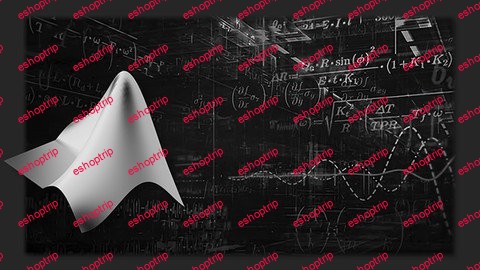Published 11/2023
MP4 | Video: h264, 1920×1080 | Audio: AAC, 44.1 KHz
Language: English | Size: 3.43 GB | Duration: 4h 0m
Part 1
What you’ll learn
Basics of engineering computing with MatLab
What does contemporary calculator look like, and what functionality we want of it?
Generic algorithms (steps to take) to solve an unfamiliar engineering problem
Setting up MatLab’s interface
Simple arithmetics in MatLab
Using variables
m-files
m-files vs. live scripts.
Improving the legibility of the code
Manipulating algebraic expressions symbolically
Precision in MatLab
Making practical sense of arrays and matrices
Requirements
Basic computer knowledge
Description
This course is designed for people who want to step in to the field of using computers to solve engineering problems. But, more importantly, for people who seek to expand their thinking frontiers and thus to acquire the most valuable personal asset in engineering.The course serves as a precursor to further studies of MatLab and engineering computing, and I strongly advise you do it first before embarking on more advanced topics.Engineering today is an extremely broad term that encompasses an enormous span of fields from populational genetics to quantum mechanics. And here I imply it in this broad sense (not in the sense of “the guys that dig some dirt and wear orange hats and vests”).This course concerns itself with engineering computing also known as scientific computing, and with MatLab as a specific tool for accomplishing this.It is very important to point that MatLab is only one of such tools. The natural question to ask then is as follows, “Is it the best tool for the job?” The other reasonable question to ask is, “Can’t we just use a conventional tabletop calculator – what advantages do tools like MatLab provide?” Until you have absolute clarity with the above questions there is no point to proceed any further, for you will end up with a disjointed information set that can hardly be called a skill.Let me clarify matters using some common misconceptions.“You will learn MatLab programming in this course, and this is what is expected of you – to do programming in MatLab”. While the term “programming” is quite accurate when applied to MatLab (you do use a BASIC-like language to tell the machine what to do), you need not forget that it is an engineering problem that you are trying to solve. And it is not as much the knowledge of programming that is going to be decisive as a clear plan of action. This plan of action, above all, requires engineering wit and not programming skills.“There are plenty of other courses out there that teach you some baby steps in MatLab, but the industry wants you to be able to do real stuff like apply the convergence properties of the Nelder-Mead simplex method in low dimensions”. This is not the case in Engineering where the knowledge of a particular optimisation method or any other mathematical abstraction, or the fact that you can plot a 3-D graph or code a two-way user interface in MatLab is of virtually no use at all. What is needed and is indeed expected of an engineer is to design a plan of action (the computational algorithm), find suitable mathematical methods, and automate the entire task using tools like MatLab. In plain words, the most valued and sought-for skill is a multi-dimensional and highly non-linear way of thinking.This is why, by far the main goal of this course, as well as all my other courses, is to instil a habit of asking “Why things are the way they are?”You will find more information if you watch the course introduction lectures.
Overview
Section 1: General Material
Lecture 1 Task description
Lecture 2 Course notes
Section 2: Course Introduction
Lecture 3 How I teach.
Lecture 4 Why do it?
Lecture 5 Course makeup and tools
Lecture 6 Additional tools for the course
Section 3: Introduction to Engineering Computing
Lecture 7 Machines v.s. humans. Hard and soft problems
Lecture 8 Why use machines when performing calculations?
Lecture 9 Modelling v.s. a real life experiment. Why iterate?
Section 4: Introduction to MatLab
Lecture 10 MatLab. First introduction
Lecture 11 Why use MatLab? What do we want of a contemporary calculator?
Lecture 12 The power of iterations
Lecture 13 MatLab. Basic usage techniques
Lecture 14 m-files. More details
Lecture 15 m-files. Storage and organising
Lecture 16 m-files. Code structure and formatting
Lecture 17 m-files. Basic Template. Working through code errors
Section 5: Introduction to Task 1a
Lecture 18 Skills required
Lecture 19 A few words on the Lorentz Transformation
Lecture 20 Entering Matrices in MatLab
Lecture 21 Practical example #1. Controlling bulb’s brightness
Lecture 22 Practical example #2. Transmission controller
Lecture 23 A few words on equations in general. Symbolic v.s. numeric
Lecture 24 Entering equations as symbolic in MatLab
Section 6: Debrief of Task 1a
Lecture 25 Debrief
Section 7: Introduction to Task 1b
Lecture 26 Automating transposition. The essence of Task 1b
Lecture 27 Implementing automatic transposition in MatLab
Section 8: Debrief of Task 1b
Lecture 28 Debrief
Section 9: Epilogue
Lecture 29 What’s next?
Lecture 30 The tasks of Part 2
General public with interest in engineering
Homepage
https://anonymz.com/?https://www.udemy.com/course/introduction-to-engineering-computing-with-matlab/











Reviews
There are no reviews yet.